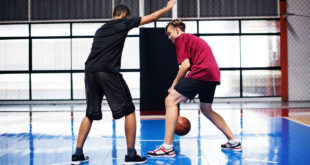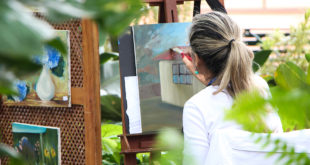It was late, as usual. Only the lights from Palikir Church illuminated the outside world as I said my goodbyes to the remaining church members and turned to leave. Perched on the threshold, I scoured the shadowy ground for my pair of slippers (flip-flops) among the many pairs that littered the floor around the door. After months of living on the island of Pohnpei, Micronesia, where all homes and churches abide by a strict no-shoe policy, I developed a knack for identifying my pair from the nearly identical mass of slippers at the entryways. But as practiced as I was at spotting my beloved black flip-flops, I couldn’t find them.
Someone must’ve mistaken mine for theirs, I thought. It happened often enough, though not as often as you’d think, with only two suppliers providing the slippers for everyone on the island. After a fruitless inquiry, I grabbed a pair of the same color, though a few sizes too big, and slipped them on. I immediately felt an unfamiliar deep ocean, where the wave ridges dug into my feet.
My toes squabbled for a proper hold as I shuffled to the waiting bus, trying to keep the slippers from falling off. On the way back home, I toured the rows of volunteers.
“Slippers! Missing slippers! Does anyone have my slippers?”
All shapes and sizes of shoes and toes were thrust out for inspection but to no avail. No one had my slippers. I slumped into an empty seat and pursed my lips. I knew it was silly, but I wanted my slippers back. My comfy bay where all the sandbanks were in the right place, and my feet weren’t grappling for purchase every step. These were not my slippers, and my feet knew it.
Adjusting
My dear and homey pair of slippers had not appeared the following day. I nearly drowned my feet into the slippers I had picked up the night before and shuffled into my day. As the hours passed, my feet accustomed themselves to the odd workings of these particular shoes, and by the end of the day, it felt as if they’d shrunk: I no longer consciously lifted my feet a little extra high to ensure that the shoes wouldn’t fall off because of their size. I had adjusted.
A few days later, the only difference I noticed between my new acquaintances and my old ones was that the white “Pohnpei” logo featured some black pen marks, probably to keep them from being mistaken for another pair, ironically. In them, I was right at home.
Readjustment
Then, our principal asked me if I’d ever found the slippers I had been looking for at the church. He had figured out who had my slippers! The next day I exchanged my ocean home for my bay residence again—only to find that my original slippers no longer felt like home! My once-comfortable normal now felt uncomfortably new, and my feet again had to readjust.
There was nothing wrong with my original slippers, but my perspective had changed. I had adapted to a new “normal.”
My experience was a comfort when I went through a much more significant change: returning to America after my time in Pohnpei. My slippers experience reminded me that even though life leads us into unexpected and uncomfortable situations, we are rigged to adjust, adapt, and flex. We can move with the unknown and know that the unknown becomes home with time.
If you liked this, you might enjoy, Community and Service
Lindsey Crumley writes from the Pacific Northwest.
© 2002 - 2025, AnswersForMe.org. All rights reserved. Click here for content usage information. Answers for Me Support & encouragement for every-day life
Answers for Me Support & encouragement for every-day life



